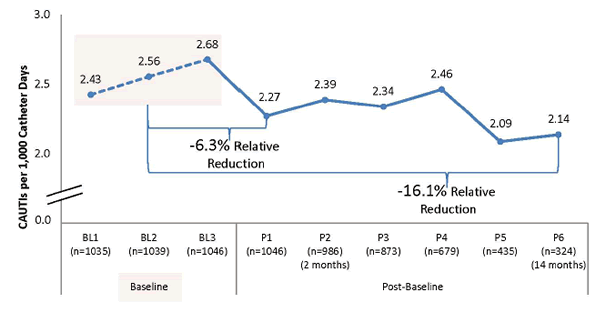Healthcare-associated infections (HAIs) are a significant cause of illness, death, and excess cost in all health care settings. At any given time, HAIs affect 1 out of every 20 hospital patients. The U.S. Department of Health and Human Services' National Action Plan to Prevent Health Care-Associated Infections: Roadmap to Elimination focuses on the need to dramatically reduce these infections. As part of the National Action Plan, the Agency for Healthcare Research and Quality is funding a nationwide effort to promote the use of the Comprehensive Unit-based Safety Program (CUSP) to prevent catheter-associated urinary tract infection (CAUTI) in U.S. hospitals. This project combines the implementation of general socio-adaptive approaches to improve care in a particular unit or hospital coupled with evidence-based interventions focusing on the technical aspects of CAUTI prevention.
The On the CUSP: Stop CAUTI project is a unit-based initiative with a primary goal of reducing the CAUTI rate in hospital units participating in the project by the completion of the 4-year initiative. Secondarily, this project seeks to make decreased CAUTI rates sustainable through fostering a culture of safety in participating units. The collaboration is led by the Health Research & Educational Trust and its partners, the Michigan Health & Hospital Association's Keystone Center for Patient Safety & Quality, St. John Hospital and Medical Center, the University of Michigan Health System, and the Johns Hopkins Medicine Armstrong Institute for Patient Safety and Quality, collectively referred to as the national project team.
To build on the strength of this collaboration and expand national support capacity, an Extended Faculty network has been developed. This Extended Faculty group is a network of content experts from professional societies well known throughout health care: the Association for Professionals in Infection Control and Epidemiology, the Emergency Nurses Association, the Society for Healthcare Epidemiology of America, and the Society of Hospital Medicine. This pool of faculty members serves as an additional resource for content development, leadership, and coaching for all stakeholders participating in the On the CUSP: STOP CAUTI national collaborative.
As of July 15, 2013, 6 cohorts have registered, collectively representing more than 850 hospitals and over 1,300 units located in 37 States, the District of Columbia, and Puerto Rico. The project continues to expand by increasing its reach both to new geographic locations and to new areas of the health care system, as well as by broadening exposure of participating units to national experts, and does so in an inclusive manner involving hospitals of all types, including rural and urban, teaching and non-teaching.
Overall, preliminary outcome data show that, among participating units, there has been a decrease in CAUTI rates from baseline, as shown in Figure 1, ranging from 6.3 percent relative reduction during post-baseline period two (2 months post-baseline) to 16.1 percent relative reduction during post-baseline period six (14 months post-baseline). Relative reduction improvements were more prominent in non–intensive-care units (ICUs) compared with ICUs. Catheter utilization rates have also been measured; these rates have stayed relatively constant over the time periods. Regarding both measures, it is important to note that due to the project's approach of staggered cohort implementation, CAUTI rates do not yet represent the complete data for all cohorts, as only cohorts 1–3 have completed participation and all remaining cohorts continue to submit data across all collection periods. Therefore, caution must be exercised when interpreting relative reductions and rates in later time periods, as additional data submission and analysis is ongoing.
Figure 1. CAUTI Rate of Units Reporting One Baseline and One Post-Baseline Data Point (CAUTI/Device Days x 1,000)

Future work will include both additional analyses and continued improvement efforts, as described below. Measures related to safety culture are key to assessing project-related improvements in patient safety culture. Two such culture measures are being collected throughout project participation: the Hospital Survey on Patient Safety Culture and the Team Checkup Tool. Ongoing efforts continue to increase culture-related data submission, and future analyses will be conducted with increased submissions.
While the majority of participating units have successfully submitted data after registering for the project and have either shown a reduction in CAUTI or maintained a zero-CAUTI rate from baseline, efforts are ongoing to assist any units that continue to need project support. The national project team is working to identify opportunities for units experiencing difficulty with data submission and/or working to offer targeted interventions for units not yet able to reduce the CAUTI rate or sustain a reduced rate in order to enhance future cohort success. Some of this guidance comes from site visits conducted by national project leadership. In addition to providing such direct participant support, an Interdisciplinary Academy for Coaching and Training was developed in collaboration with experts at the University of Michigan and the Society of Hospital Medicine as a way to improve coaching, teamwork, and integration for faculty and State leads who provide this ongoing support and expertise to all project participants.
The project continues to expand with the completion of cohort 6 registration and the planning of cohort 7 registration underway. Additionally, the national collaborative has expanded its reach to Emergency Departments and broadened participant exposure to even more nationally known experts. These efforts alongside the progress made toward achieving the project's stated goals are encouraging, and they indicate that focused attention on reducing CAUTI using an effective approach that combines the technical and adaptive aspects of implementation can produce important results.



